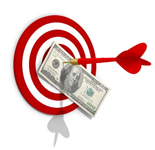The majority of small businesses base their pricing models on the Cost of Goods Sold (COGS) rather than the Customer Perceived Value (CPV). While pricing models’ successes vary between industries, Customer Perceived Value is a proven method to insure one of the highest, if not the highest margin for your product/service.
Having extensive experience within the hospitality industry and exposure to a number of small business owners, I find it surprising to see the number of businesses focused on Cost-Plus Pricing and Marketplace Pricing.
For simplicity we will focus on the restaurant industry. Cost-Plus Pricing means an owner is focused on maximizing profits within the business by focusing on the COGS. Once all food costs are calculated, he multiplies by 4 to determine the retail value (e.g., if a chicken dish costs $4 to deliver, it will be listed at $16 on the menu); roughly one quarter for the COGS ($4), one quarter for labor ($4), one quarter for fixed expenses ($4), and an ideal 25% profit margin ($4).
Customer Perceived Value can vary greatly depending on the product or service and industry. However, specific to restaurants, the variables that come into play are static: location, ambiance, service, competitor pricing, mealtime (i.e., lunch versus dinner), etc. Unfortunately, prices are printed in menus and must remain fixed for all patrons in a given night.
Regardless, some restaurants provide similar dishes, stellar service, and are located in popular or convenient locations, but price their dishes differently. For example, The NoMad in NoMad versus Nomad in the East Village (Disclosure: CNSLT.us Client).
The NoMad at Eleven Madison Park, managed by Chef Daniel Humm and Restaurateur Will Guidara, is well known for its $78 chicken. However, as food critic Jim Webster notes, the original Nomad’s “menu prices were reasonable. I mean, I heard it was casual, but by NYC standards, this place was downright affordable.” Its most popular chicken dish, Chicken Pastilla, is a mere $16.
Broadly speaking, Cost-Plus Pricing leads to one of two pitfalls: 1) if the price is higher than the customers’ perceived value the cost of sales will increase (e.g. discounting); 2) if the price is lower than the customers’ perceived value sales will increase, but the business will not be maximizing its profit potential.
When businesses focus on Marketplace Pricing models, they relinquish their right to differentiate their product or service from competitors. As a result, their margins are thin and their product commoditized. Starbucks is one of many businesses that have successfully differentiated their product, which is a commodity that would otherwise cost $0.99.
However, Customer Perceived Value Pricing can sometimes result in a profit-margin rut where executives are determined to meet a specified gross profit objective for each individual product. Unfortunately, not all products’ perceived value is uniform, and not all products’ costs are directly correlated with their perceived value. Using Customer Perceived Value Pricing correctly will result in varying margins. The NoMad makes a significant higher margin on their chicken dish then their crudité.
So, how much do you pay for a cup of joe?

